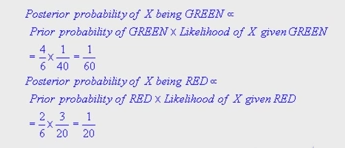Data Science and Machine Learning Internship ...
- 22k Enrolled Learners
- Weekend/Weekday
- Live Class
Based on the Bayesian theorem, Naive Bayes Classifier is a simple probabilistic classifier with strong independent assumptions. It assumes that the presence or absence of a particular feature is unrelated to the presence or absence of another feature. A fruit may be considered to be an apple if it is red in colour, round and about 4 in diameter. Even if these features depend upon the existence of another feature, the classifier considers all of these properties to contribute to the fruit being an apple.
Above is an example mention and the objects are classified as green and red. The task is to classify new cases that arrive and understand to which class they will belong i.e. red or green.
Here we see that there are twice as many green objects as red and it is reasonable to believe that the new object is likely to be associated with green rather than red. In the bayes theory, it is known as prior probability. Prior probabilities are based on previous experiences and are used to predict outcomes before they actually happen. Thus we can write
Prior probability of green= Number of green objects = 40
Total number of objects 60
Prior probability of red= Number of red objects = 20
Total number of objects 60
Determine Prior Probability


The likelihood further indicates that the class membership of X is red since there are more red in the vicinity of X. According to Bayes classification, the final outcome is judged by combining the prior and the likelihood to achieve a Posterior Probability.

Finally, we classify X to belong to red since its posterior probability is high.
Got a question for us? Mention them in the comments section and we will get back to you.
Related Posts:
Association Rule mining with Data Science
 Thank you for registering Join Edureka Meetup community for 100+ Free Webinars each month JOIN MEETUP GROUP
Thank you for registering Join Edureka Meetup community for 100+ Free Webinars each month JOIN MEETUP GROUPedureka.co